Self-Awareness
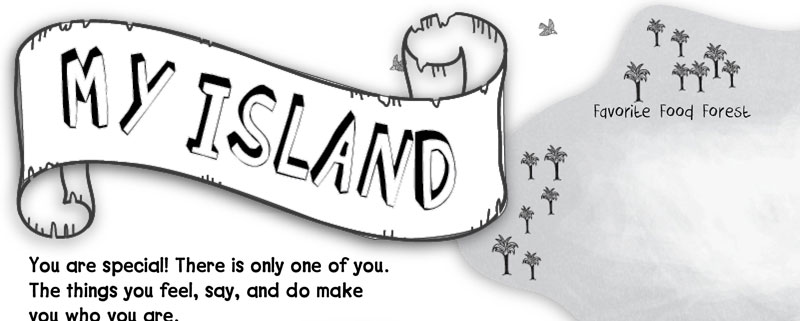
Find this activity in the student portfolio
Objective: Students will be able to identify who they are, what they like and dislike, and recognize their strengths and weaknesses.
Estimated Duration: 20 minutes
Description: Self-identity is how you identify and define yourself. It is made up of many parts including your values, beliefs, personality traits, physical attributes, abilities, hobbies, and interests. It is the combination of these things that make up your self-identity. It’s important to have a strong sense of self-identity to be able to adapt to changes and overcome challenges. Having a strong sense of who you are can help anchor you during uncertain times and help you develop positive self-esteem.
When helping children discover their self-identity, it is important to encourage them to look at all the things that make them who they are and not to identify with just one part or a few parts of themselves.
When children tie themselves firmly to just one part of who they are, they can struggle to find their self-identity if they experience failure or are not successful in that one part. Knowing that they are so much more can help them develop a strong sense of self-identify.
This activity will allow students to think about who they are at this moment. They will document things they are good at, some of their favorite things, family members, and friendships that are important to them.
Teachable Moments: There are many ways you can help improve and build self-identity in your students:
- Emphasize healthy values.
- Teach students to recognize unhealthy media messages.
- Highlight students’ strengths and passions.
- Encourage students to get involved in healthy activities.
- Ban harsh criticism.
- Be a good role model.
- Let students help.
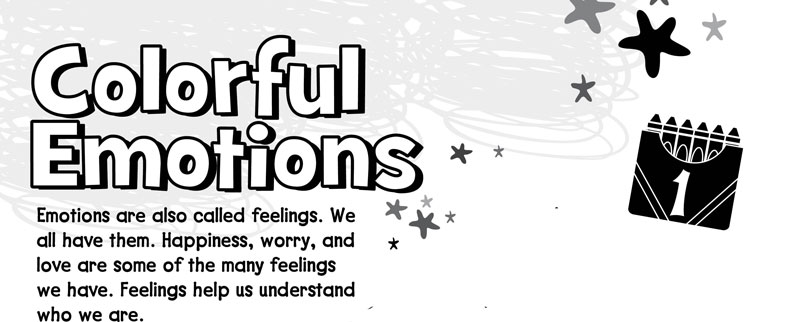
Find this activity in the student portfolio
Objective: Students will be able to identify their emotions.
Estimated Duration: 20 minutes
Description: Emotional awareness is the ability to notice, accurately name, and interpret our emotions. It is an important skill students need to be successful in life.
Emotional awareness helps us know what we need and want (or don't want!) and helps to build better relationships. Being aware of our emotions can help us talk about feelings more clearly, avoid and resolve conflicts appropriately, and move past difficult feelings more easily.
This activity will help students identify their feelings and the behaviors associated with them. First, they will color familiar emotions. Then, they will name and draw one of their emotions. Last, they will write about what happens when they feel that emotion.
Teachable Moments: There are many ways you can help students identify their emotions:
- Talk about your emotions and feelings; ask students about theirs.
- Have students name their emotions and the behaviors associated with them (e.g., happy = smile, sad = cry, angry = stomping feet).
- Model reactions and emotional behavior.
- Use picture books to illustrate different emotions and facial expressions.
- Role play classroom situations that result in big feelings; ask students to talk about how they would feel if this happened to them; have them come up with ways to cope with big feelings.
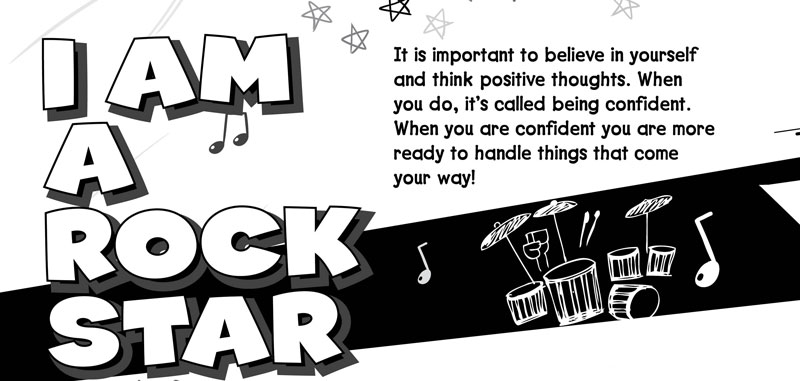
Find this activity in the student portfolio
Objective: Students will build self-efficacy.
Estimated Duration: 20 minutes
Description: Self-efficacy is the belief that you can perform a task or manage a situation. It is about learning how to persevere when you fail at first. Self-efficacy can be motivating. Research shows that students with a strong sense of self-efficacy believe they can accomplish more difficult tasks.
In the face of failure, these students increase and sustain their efforts to be successful. They approach difficult or threatening situations with confidence that they have control and conquer them. Conversely, students who doubt their ability to accomplish difficult tasks see these tasks as threats and give up quickly.
This activity will help students build self-efficacy by having them create compliments about themselves. They will fill in the star with words, drawings, or pictures from old magazines that show their compliments. Suggest students come back to this page throughout the year for a little boost of confidence if they need it.
Teachable Moments: There are many ways you can improve and build self-efficacy in your students:
- Choose task difficulty levels wisely.
- Use peer role models in the classroom.
- Allow for active feedback from students.
- Allow for active feedback from teachers.
- Promote efficacy in teachers throughout the school.
- Provide problem-solving opportunities.
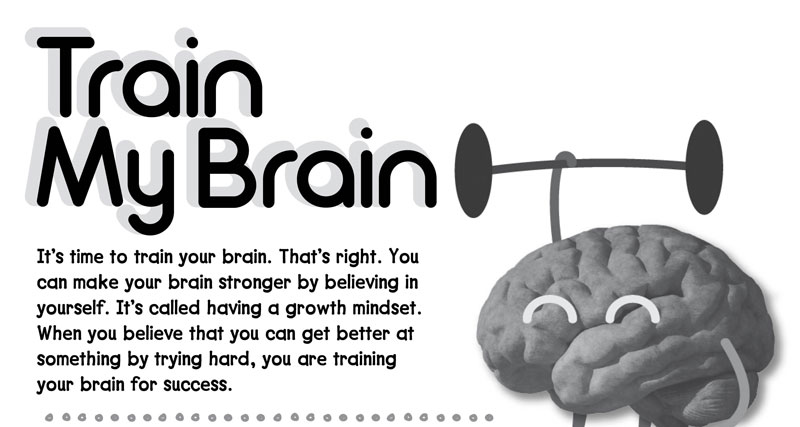
Find this activity in the student portfolio
Objective: Students will build a growth mindset.
Estimated Duration: 20 minutes
Description: A growth mindset is when you believe your intelligence and abilities can be improved with effort and the right strategies. It is important for students to learn to use a growth mindset because it can help them overcome obstacles when they learn something new or develop a new skill.
When students use a growth mindset, they understand the importance of persistence and determination. They see roadblocks and constructive feedback as ways to help themselves learn and progress. Instead of giving up in the face of challenges, students with a growth mindset keep going because they believe they can achieve the goal.
This activity will help students build a growth mindset by learning to use the word yet. Students will draw or write about something they can already do that they are very proud of. Then, they will draw or write about something they cannot do yet, but they will be able to once they work hard at it.
Teachable Moments: There are many ways you can help improve and build a growth mindset in your students:
- Be mindful of feedback; emphasize improvement over talent and intelligence.
- Praise the process, not just the result.
- Include reflection as a part of assignments.
- Discuss your own experiences and struggles.
- Explain that failure is a part of the process of learning new things.
Foldable®: Selfie Moments
Estimated Duration: 25-30 minutes
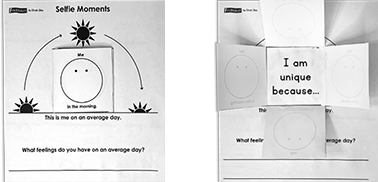
- Cut along the solid black lines of the page with four mouth-less faces. Discard the squares with hatch marks. Keep the square that says, “This is how I feel…”
- Fold along the four dotted lines. Fold so the dots show along the fold lines. Students might help each other fold.
- Collapse the tabs inward to form a single square with a face on the front. As they open and close the tabs, have students complete the pictures of themselves. Discuss how student emotions can differ at different times of the day.
- With all tabs open, glue the “This is how I feel…” square in the middle of the cross. It will be covered when the tabs are closed and visible when the tabs are open.
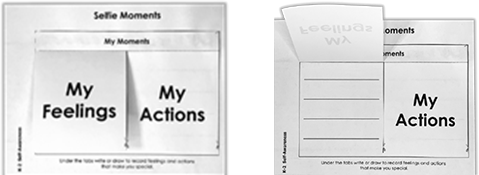
- Cut along the outside solid black lines of the My Moments Foldable. DO NOT cut the middle black cut-line at this time.
- Fold along the dotted line at the top of the rectangle to form an anchor tab. Glue the folded tab on top of the gray My Moments anchor tab space in the student book. Allow the glue to dry briefly while you discuss what types of feelings and actions students might experience.
- NOW have students to cut along the middle solid black line to form two tabs. Have students record feelings and actions that make them special under the tabs. Their writing and sketches are private when covered by the tabs.
Go to other SEL competencies in this book (Primary - Grades 1–2):

The teaching suggestions only work in accompaniment with the student portfolio, which has all the activity pages.
The teaching suggestions here are also available within a PDF of the entire teacher's manual.